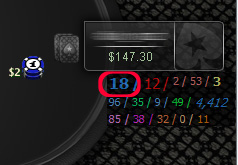 Stealing Blinds (SB/BB Fold Vs Steal).
Stealing Blinds (SB/BB Fold Vs Steal).
We now come to one of the most overlooked aspects of the online poker game – the issue of stealing blinds. An attempt to steal is when someone raises from the CO, BTN or SB when the pot is unopened.
The micro limits up to 50NL are abundant with players who fold their small blinds to a steal 90% and their big blinds 80% of the time, which means you can be profitable by playing the simplest tight ABC poker provided you frequently steal from late position; in fact that’s exactly what most multi-table grinders there do. Stealing and defending blinds becomes a matter of survival at higher levels and especially at shorter tables, where the blinds rotate almost twice as fast.
Let’s make a simple calculation to illustrate the importance of blind stealing.
Say you are on the button with two weak-tight players behind you, who fold to steal their SB 90% and the BB 80% of the time. This means they will both fold an average of 0.90×0.80=0.72, i.e. 72% of the time.
So, if you bet 3xBB and instantly fold if you get called, every 100 situations you’ll win an average of 72×1,5=108 and lose 28×3=84 for a total profit of 24 BB or 0,24BB per steal!
Against timid opponents I would suggest stealing with the top 50% of hands (any Pair, any two Broadway cards, any Ace, King or Queen and any suited connectors down to 65s). You have to understand that your 50+ range against even the small blind’s 10% of top hands statistically has you as underdog only 36/64, meaning you’ll catch cards and win often even when you get called. Plus, if your opponents don’t start to defend, steal-raise them with any two cards! Players who fold their blinds 90% of the time have severely limited poker skills and won’t know how to counter your constant stealing.
Against average opponents who fold 65-85% of the time I would reduce my stealing range to the top 40% of hands, and for players who fold about 55-65% I would change my stealing range to the top 30% of hands.
Against overly defensive players with stats of below 55% folding I would reduce it further still and raise from LP mainly for value.
Examples using SB/BB Fold Vs Steal
/For sake of simplicity we’ll assume all opponents have stacks of about 100BB/
Full ring table, you are on the button with A3o. Everyone before you folds. What do you do? Let’s see the stats.
a) Small blind: VPIP=22 / PFR=8 / SB Fold Vs Steal=83 / SB 3-Bet Vs Steal=4
Big blind: VPIP=17 / PFR=7 / BB Fold Vs Steal=78 / BB 3-Bet Vs Steal=5
We have two weak-tight players behind us and we should definitely raise here because:
1. There’s a significant chance they will both fold (65%, 0.83×0.78).
2. We actually have the best hand against two random hands.
3. We are 41/59 against the calling range of the small blind and 42/58 against the calling range of the big blind. In short: we are only a small underdog if we get called.
4. We have position on them and can outplay them later in the hand.
b) Small blind: VPIP=22 / PFR=8 / SB Fold Vs Steal=83 / SB 3-Bet Vs Steal=4
Big blind: VPIP=17 / PFR=7 / BB Fold Vs Steal=48 / BB 3-Bet Vs Steal=6
In this scenario the BB is overly protective – he defends more than half the time. The blinds will both fold 40% of the time and re-raise only with the top 4-6% of hands. Our A3o against the big blind’s 50% range is a coin flip and even against the small blind’s 13% calling range we are only 47/53 underdog, so we can still profitably attempt to steal!
(Please note that hands with an ace in them do better against wide calling ranges; 87s is in theory a top 40% hand but against a wide 50% range it is 2 to 3 underdog, while A3o is 50/50. A3o and 87s have the same showdown equity only against the top 5% range, but you should be more inclined to call tight re-steal ranges with medium suited connectors because they can flop disguised monsters instead of the obvious and dominated paired aces).


